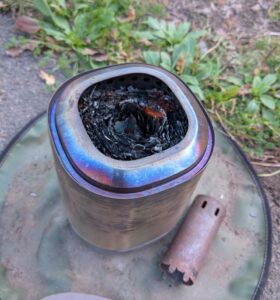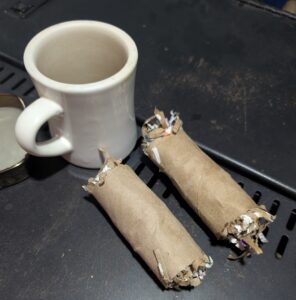A friend of mine recently purchased a new home in the outer edges of an urban area, it’s pretty much in the sleepy suburb next door. She and her boyfriend purchased a solo stove and upon firing it up on their brick patio and settling in with a cold adult beverage, fire trucks pulled up. Apparently the solo stove and fire pits are illegal in their neighborhood. I understand the ban in urban areas where the houses are close together, but it got me looking into my neighborhood.
Fire pits are explicitly banned for my street. Solo stoves are not mentioned, but I am allowed to have a charcoal grill.
For a fire pit to be legal you need to be on certain streets and the pit must be 25ft from any inhabitable structure. All of the houses abutting my property have a good sized yard and mine is more than long and wide enough that I can be 25ft from any inhabitable structure.
That’s where I place my solo stove, uh charcoal grill.
Because I love firing up my charcoal grill in the fall months I got thinking about alternative briquettes. Charcoal isn’t expensive but it isn’t cheap either. Also I was making charcoal this summer for art making. It got me to thinking about the paper and cardboard in my recycle bin.
I made a few coiled up “logs” from cardboard. I was pretty shocked at how well and how HOT they burned. Once the log was even with the secondary burn holes on the burner, I got a good clean burn that was hot enough to cook over for about 20 minutes and simmer for at least another 10. All that was left was a fine powdery ash. Fascinating. I posted about this and because Big Brother is always watching and listening, YouTube started to feed me videos on making recycled paper briquettes.
I’m not going to lie I watched all of them, especially those from this dude in Japan. I liked his because he is experimental and also shows them burning and uses them for cooking. I don’t understand much of what he says but I enjoy it.
This has led me to some experimentation of my own.
A few weeks ago I gathered all the recyclable paper products in the house and ran them through the paper shredder and then soaked them overnight before stuffing the wet soggy mix into toilet paper tubes. I squeezed out most of the water as I stuffed the tubes. It took them a week to mostly dry and now they rest behind the pellet stove. As they dry I stuff a few into the pellet stove here and there. They burn hot and fast- my hand strength only compacts them so much. I suspect the TP tube size will be perfect for my solo stove, uhhh, charcoal grill. 
This has led me to a further experiment. I’ve collected all of the recyclable paper, card, and cardboard that has entered our home and run it through the shredder. On Tuesday I had gathered a pellet bag full and I’ve just now finished the week long gather with another half bag of shredded paper and cardboard. The paper and cardboard needs a few days to soak for the harder stuff to break down. I’m adding in card from soda cases but that is proving to be quite a difficult task. It is resistant to soaking and is not blending in well at all. I will probably separate out the soda cases in the future. I suspect they will need at least a week to soak before they will blend into the pulp well.
The process is this- shred paper. Put paper into a bucket. Cover paper with more water than I think it needs. Let it soak at least 3 days. Use a paint mixer on a drill to beat and macerate the pulp. Put pulp into a paint strainer, allow some water to drain out. Keep it wet but not liquid. Stuff handfuls into the form. Press.
My first experiment was using a vitamin jar with the top removed and holes drilled every couple of centimeters. I made a sling to be able to remove the briquette from the form. To press the briquette I used a large medication bottle with the lid on and a carefully cut piece of plastic to perfectly fit into the form. I then stepped on the medication bottle and let the water squeeze out. I used the sling to pull the briquette out of the form. This worked well but is slow. If I were to do this again, I’d look to make something that perfectly fit into my “charcoal grill.” That way each briquette would account for an hour or so of burn time and allow me to cook a meal easily without fear of running out of fuel. I may create a wooden form for this purpose.
The next experiment is the classic caulking gun briquette maker. Thus far it compacts the briquettes more tightly than my hands can and produces something quite uniform in size. Again, a good size for my “charcoal grill” though it will require 6 to 8 of them for a full grill. This size also fits in my pellet stove and acts like an enormous pellet. They burn down to fine white ash and do not produce fly aways like loose paper does.
I am tempted to see if I can thrift a meat grinder and see if I can run pre soaked and already mostly drained pulp through it and then through a sausage attachment to create pelletized pieces.
Recycled paper briquettes are nothing new. Back in the 80s my grandparents were gifted a paper log maker. The idea was simple, take newspapers, soak them and then roll them on this contraption. The contraption was supposed to squeeze out the excess water and the log would slide off the form. You were then to let it dry. However, my grandparents found the process annoying and the logs never dried. First off it was hard to get the wet paper into the center tube, the paper would also slide off the tube, then if you did magically get the paper in there, it was hard to get the log off the tube if you got the paper tight enough to make a good log. Also the log would drop down into the water in the trough. Then once you made a log, it just never dried, even next to a roaring fire. It stayed damp for ages. Then it would mold. Once it molded burning it produced an unpleasant odor. They used it a handful of times and now it still sits next to the pot belly stove in the living room. Clearly many people used these in some form or another because eBay and etsy are full of vintage versions of them going for bonkers amounts of money.
My charcoal grill is on a fire proof mat, I keep a fire suppression blanket and fire extinguisher nearby. Could I start a fire? yes. Other than the street restriction, I am following state and city regulations regarding distance from other structures. I do not burn when the fire danger is high. Which meant that most of this summer and fall I did not light up my charcoal grill and instead used my gas grill.